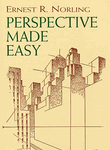Deze tips vond ik op de blog van James Gurney. De boeken gaan over perspectief tekenen, anatomie van dieren, dieren tekenen, bomen tekenen, model tekenen en de stap van tekening naar schilderij. Ik mocht ze overnemen met vermelding van zijn eigen (overigens super goede boek) Imaginative Realism
Perspective can be a daunting topic, like advanced mathematics, but in its most basic form, it is easy to grasp. Norling does a good job of emphasizing the most fundamental points, especially the all-important subject of eye level. He concentrates on the familiar problems faced by most artists, such as one-, two-, and three-point perspective.
This is a useful reference book, dominated by large and carefully drawn plates. The animal kingdom is represented by a small number of familiar domesticated mammals: horse, dog, cow, and goat, together with a lion. Each animal is shown in neutral poses in side, top, and front views, with skeletal and muscular dissections for comparison.
Disney animator Ken Hultgren shares an approach to drawing animals that emphasizes the unique characteristics of all the major types of mammals. His style features action poses ranging from straight to cartoony. His pen-and-ink drawings are usually accompanied by a skeletal analysis to help students see the hidden structure. He never loses sight of the lines of action flowing through a pose, something that both realist painters and cartoonists can benefit from.
This book is a good one to consult when one needs a reminder that not all trees look the same. Cole draws upon the Victorian tradition of close observation of nature, and he analyzes trees at the level of roots, branches, stems, blossoms, leaves, and foliage masses. The book transcends the limits of a botanical treatise by exploring artistic issues, such as the grouping of masses and the simplification of contours. The text is profusely illustrated with black-and-white explanatory drawings, as well as compositions by early masters.
Bridgman's Life Drawing by George Bridgman
Bridgman's legendary figure drawing demonstrations at the Art Students League of New York have inspired generations of artists, from Norman Rockwell to Frank Frazetta. His dynamic, chunky form analysis reminds students of the big shapes and how they interlock with each other, which is easy to overlook when faced with the subtleties of the actual figure.
Bridgman's Life Drawing by George Bridgman
John Vanderpoel, who studied in France at the Académie Julian, offers a classical approach to figure drawing, noteworthy for its timeless grace. His approach focuses on the important planes of the figure understood in terms of simple light and shade. Male and female models are analyzed in many detailed drawings of parts, such as the head, neck, torso, and limbs. The plates are so good that it would profit a student to systematically copy all of them.
Harold Speed's classic text bridges the often-difficult gap between drawing and painting. He starts with a tutorial on seeing, the foundation of accurate drawing. He distinguishes between line drawing and what he calls 'mass drawing'—essentially monochrome painting. Although his writing style might strike some modern readers as old fashioned and opinionated, he makes a good case and covers useful aesthetic territory.
Tekenlessen: www.detekenacademie.nl








Geen opmerkingen:
Een reactie posten
Geef zelf een tip of reageer: